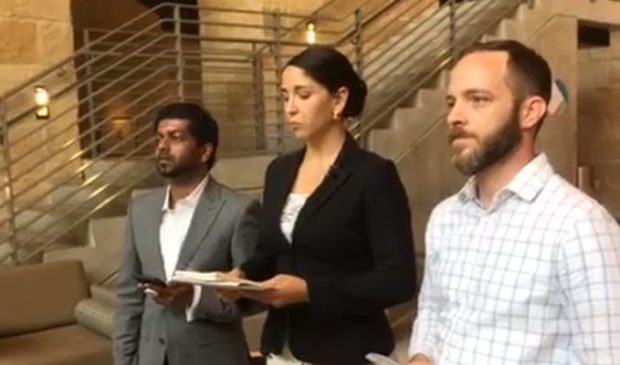Planning commissioners propose ‘anti-McMansion ordinance’ for CodeNEXT
Tuesday, May 15, 2018 by
Jack Craver Three members of the Planning Commission have proposed a series of “anti-displacement” measures in CodeNEXT that they say will discourage demolitions of existing low-cost housing and incentivize the construction of smaller units that middle-income people can afford.
Speaking to reporters at City Hall Monday before kicking off yet another marathon meeting of the Planning Commission on CodeNEXT, commissioners Angela De Hoyos Hart, Fayez Kazi and Conor Kenny unveiled what they called an “anti-McMansion ordinance,” a reference to the current “McMansion ordinance” that they said is woefully insufficient.
They pointed to statistics showing that most single-family homes that are demolished are replaced by larger single-family homes. When single-family homes are demolished, only 34 percent are replaced by duplexes and 7 percent by multifamily developments. Fifty-nine percent are replaced by other single-family homes.
The average demolished home is 1,430 square feet. The average home that is replacing it is 3,544 square feet.
A handout that the commissioners provided to media framed the choice: “Which future do you want for our city? McMansions for the few? Or modest-sized homes for many?”
To that end, they have proposed restricting the size of new single-family homes built to 30 percent of the lot area, down from the current 40 percent maximum. However, if the demolished structure is replaced by multiple units, the developer will be allowed to use up to 40 percent of the lot.
Kenny said that the CodeNEXT consultants had estimated that such a rule would reduce the chance of demolitions by 10 percent. But more importantly, he argued, the new regulation would incentivize developers to build housing that is more likely to be affordable to middle-income people, rather than large single-family homes that would only be accessible to the wealthy.
The second part of the anti-displacement agenda is an “affordable ADU bonus,” which would grant greater entitlements to developers if they also built an accessory dwelling unit (or “granny flat”) restricted to lower-income families.
Finally, the three commissioners proposed that upzonings be focused outside of the city’s Eastern Crescent. The goal is to incentivize housing capacity in more affluent areas of the city to “relieve” development pressure on the rapidly gentrifying east side.
De Hoyos Hart said that while the proposed changes would not “cure all the issues we’re facing, we must act so that our status quo code can’t continue to push out Austin’s most vulnerable.”
In a statement released Monday, four City Council members – Greg Casar, Delia Garza, Pio Renteria and Jimmy Flannigan – expressed support for the proposed policies.
“We need a simpler code that allows smaller homes and smaller lots throughout Austin,” said Garza. “The Planning Commission has been working hard for months to send to Council a code that both helps our low-income families stay in their homes and creates new opportunities for affordability.”
Late in the evening, the anti-McMansion ordinance was adopted, with only Commissioner Karen McGraw in opposition. At press time, the commission had yet to vote on the ADU bonus or the upzonings proposal.
Curious about how we got here? Check out the Austin Monitor’s CodeNEXT Timeline.
The Austin Monitor’s work is made possible by donations from the community. Though our reporting covers donors from time to time, we are careful to keep business and editorial efforts separate while maintaining transparency. A complete list of donors is available here, and our code of ethics is explained here.
You're a community leader
And we’re honored you look to us for serious, in-depth news. You know a strong community needs local and dedicated watchdog reporting. We’re here for you and that won’t change. Now will you take the powerful next step and support our nonprofit news organization?


